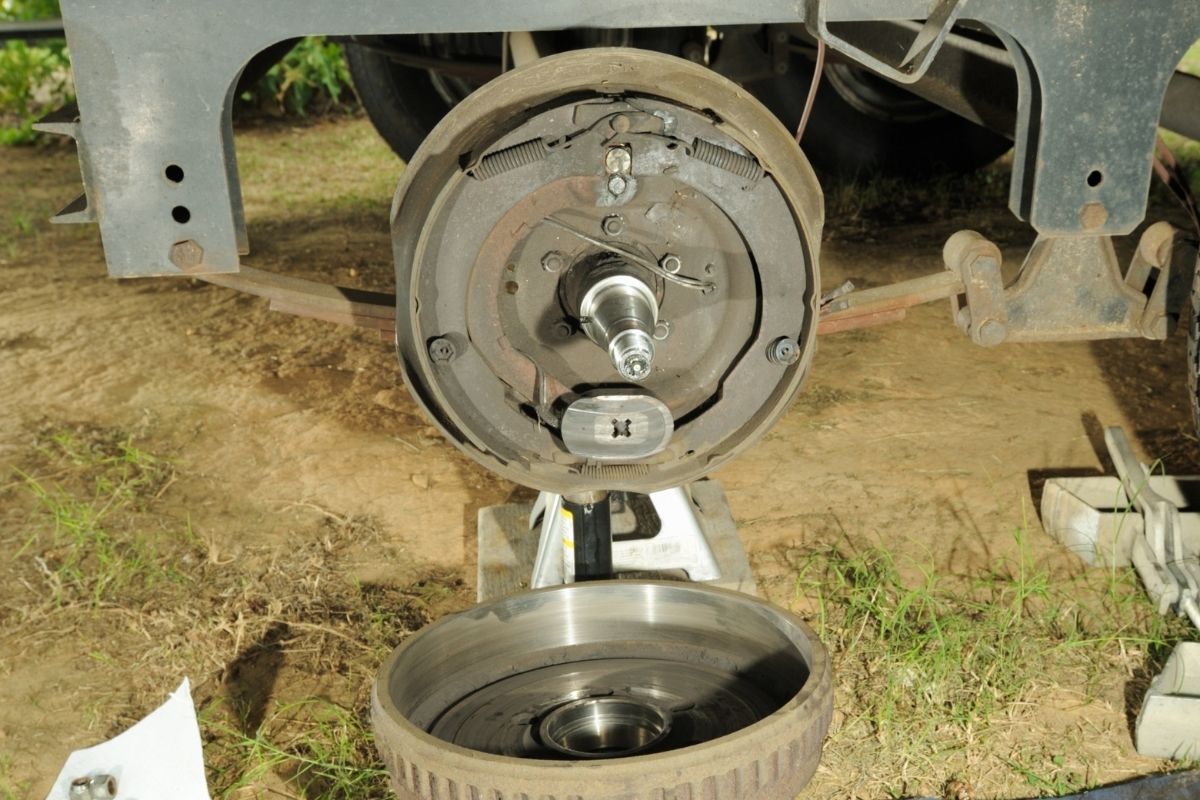Discover How To Use The Power of Authority Marketing To Make You Money While You Adventure!
No Experience, Existing Product Or Technical Skills Are Required
DO YOU BELIEVE ADVENTURES ARE WORTH CHASING?
We're an affiliate.
We hope you love the products/services we recommend on Just Van Life! So you know, there is the possibility we will collect a commission should you make a purchase via any of our links. This will in no way affect the purchase price. Thank you for your support, we really appreciate it!
The trailer hitch is the most important part of your vehicle. It holds your load securely and can be a safety hazard if it’s not working properly. If you notice any issues with your trailer, such as a loose or noisy hitch, then it’s time to get it repaired.
Repairing railer bearings is easy, but there are some things that could go wrong during the process. Here’s how to repack trailer bearings:
How To Repack Trailer Bearings
Let’s take a look at everything you need to know about trailer bearings, what to do when something goes wrong, and how to repack trailer bearings quickly and easily.
1. What Are Trailer Hitch Bearings?
Trailer hitch bearings are the parts inside the ball mount on your trailer tongue. They keep the ball from moving up and down in the socket. The two main types of trailer hitch bearings are:
– Ball Mount Bearing (BMB)
– Pin Mount Bearing (PMB)
2. How Do You Know When Your Trailer Hitches Need Repair?
If you hear rattling noises when you pull away from the stop sign or drive-over bumps, this is a surefire sign that your trailer hitch needs repair. This happens because the bearing isn’t seated correctly.
3. How Can I Tell Which Type Of Trailer Hitch Bearing Is In My Vehicle?
If you have a pin mount-type trailer hitch, then you will need to remove the cover plate underneath the bumper. Then look for the small metal rod that goes through the hole in the bottom of the bumper. There should be a plastic cap covering the end of that rod. Remove the cap and take out the rod. Look at the end of the rod. If it has a square shape, then you have a BMB. If it looks like an arrowhead, then you have a PMB.
4. How Do I Replace A Trailer Hitch Bearing?
To replace a trailer hitch bearing, first, make sure that the axle nut is loosened. Then use a wrench to loosen the bolt holding the bearing in place. Once the bearing is removed, clean off all debris. Next, install new bearings using the correct size. Finally, tighten the bolts back into place.
5. How Long Does It Take To Repack A Trailer Hitch Bearing? How Much Will It Cost?
It takes about 15 minutes to repack a trailer hitch bearing. However, this job may require special tools. So, you might want to bring along someone who knows what they’re doing. Also, don’t forget to factor in the cost of labor.
6. How Often Should I Repack Trailer Hitch Bearings? How Long Does It Last?
You should repack trailer hitch bearings every year or so. This way, you can prevent damage to the bearing and ensure that your trailer hitch works well.
7. How Do I Prevent Damage To Trailer Hitch Bearings? What Other Problems Could Be Causing Them?
When driving, avoid hitting potholes and other obstacles. These can cause damage to the trailer hitch bearing. If you do hit something, try to slow down before going over bumps. That way, you won’t jar the trailer hitch bearing.
How Often Should I Change My Trailer Bearing Grease?
Trailer bearings are the parts inside the wheel hubs that allow them to rotate freely. They wear out over time and eventually need replacing. The question is, how often should they be changed?
There are two main types of trailer bearings: cartridge and roller. Cartridge bearings are usually found in older trailers and rollers are newer. Both require regular maintenance and lubrication.
Cartridge Bearing Maintenance
The first step in maintaining your trailer’s trailer bearings is to remove the axle from the hub. This will make it easier to access the bearings. If you have a manual transmission, you’ll also need to disconnect the clutch cable.

Next, check the condition of the bearings by looking at the outside of the hub. You can see if there is any damage or corrosion on the bearing surfaces. If you notice anything unusual, such as cracks, pitting, or rust, call a professional to inspect the bearings for free.
Next, use an oil-based bearing grease to lubricate the bearings. A good quality grease will last longer than cheaper greases. Grease should not be applied with too much force or the bearings could get damaged. Use only enough pressure to spread the grease evenly around the bearing surface.
If you’re using a manual transmission, apply the grease to both sides of each bearing. If you’re using an automatic transmission, apply grease to one side of each bearing.
After applying the grease, reattach the axle to the hub and reconnect the clutch cable. Make sure the axle is fully seated before tightening the nuts. Tighten the nuts until they feel snug but don’t over tighten them.
Roller Bearing Maintenance
To maintain your trailer’s trailer bearings, follow these steps:
Step 1. Remove The Axle From The Hub
Remove the axle from the hub by removing the bolts holding the axle onto the hub.
Step 2. Inspect The Condition Of The Bearings
Check the condition of the bearings after removing the axle. Look closely at the inner race of the bearing. It should look smooth and shiny. If it looks dull or rough, it needs to be replaced.
Step 3. Lubricate The Bearings
Apply a small amount of oil-based bearing grease (not more than half a teaspoon) to the outer race of each bearing. Be careful not to get any grease on the inner race.
Step 4. Reassemble The Axle
Reassemble the axle into the hub by placing the axle back into the holes where the axle was removed. Once the axle is properly positioned, tighten the nuts.
Step 5. Check The Condition Of The Bearings Again
Check the condition of your trailer’s trailer bearings once more. Look closely at the outer race of the bearing. If it still appears smooth and shiny, it may not need to be replaced yet. However, if the bearing has become pitted or worn, it will need to be replaced.
Repairing Your Trailer Brakes
Trailer brakes are important safety features that keep your vehicle from rolling away while parked. They work by slowing down the wheels when you press the brake pedal. There are two types of brakes found on most trailers: drum brakes and disc brakes.
Drum brakes consist of a metal cylinder with a series of grooves cut into its inside wall. When you push the brake pedal, the piston moves up and down in the cylinder. As the piston goes up, it pushes against the wheel rim and slows it down. Disc brakes have friction pads that slow down the wheel by pushing against the rotating disk.
Trailer brakes can fail due to wear and tear over time. This is why it’s important to regularly service your brakes so they continue working efficiently. Here are some common problems with trailer brakes and how to fix them:
Brake Fade – The brake fade problem occurs when the brakes lose their ability to stop the trailer quickly. Brake fade usually happens gradually as the brakes begin to wear out. You might notice the brakes start to take longer to stop the trailer.
Brake Lockup – Brake lockup occurs when the brake pads stick together and prevent them from moving freely. This causes the brake pads to heat up and burn. Over time, this can cause the brake pads to crack and break off.
Brake Squeal – A squealing noise coming from the brakes can indicate a number of different issues. Some of the possible causes include:
- Loose lugnuts
- Wheel misalignment
- Poor alignment
- Bad brake fluid level
- Dirty brake shoes
- Too much pressure applied to the brake system
To diagnose the issue, check the following areas for potential problems:
- Make sure all four tires are inflated correctly.
- Check the alignment of the trailer using an adjustable wrench.
- Remove the lug nuts and inspect the wheel studs.
- Inspect the brake lines for leaks.
- Examine the brake shoes to make sure they’re clean.
Final Thoughts
In this article, we have looked at how to repack trailer wheel bearings in detail so that you have all the information you need to know exactly how to repack a trailer bearing with minimal fuss.
Discover How To Use The Power of Authority Marketing To Make You Money While You Adventure!
No Experience, Existing Product Or Technical Skills Are Required
DO YOU BELIEVE ADVENTURES ARE WORTH CHASING?
